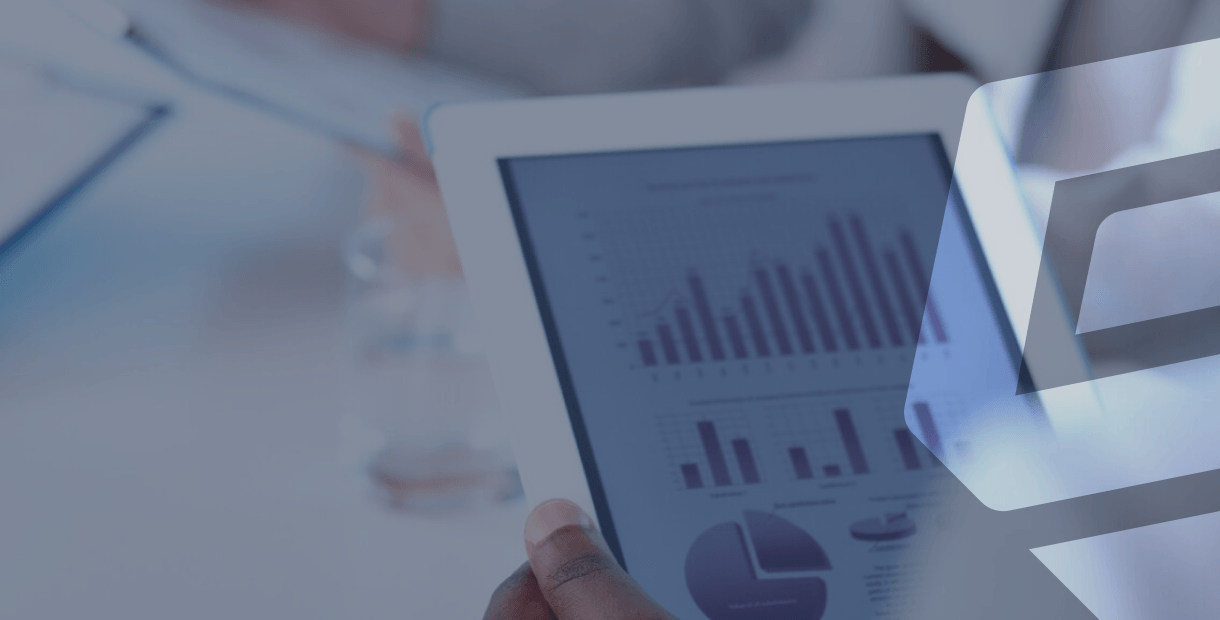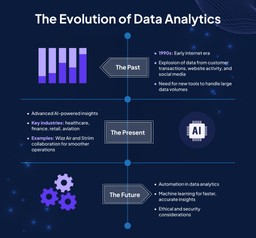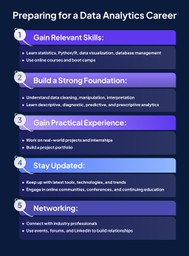Data analytics has come a long way, transforming from basic number-crunching to advanced, AI-powered insights.
Today, it’s a game-changer in healthcare, finance, retail, and even aviation. Recently, Wizz Air teamed up with California-based analytics firm Striim to boost their operations and make flying smoother for customers.
If you’re serious about growing in this exciting field, enrolling in a data analytics course is smart. You’ll gain the skills to unlock the power of data and open doors to amazing opportunities in the future.
Let’s explore the evolution of data analytics, including its past, present, and future, and see how it’s shaping the world around us!
Data Analytics Evolution: The Emergence of Big Data
Big data is a term we hear a lot these days, but where did it all start? Let’s take a trip back to the 1990s and early 2000s to understand how this revolution began.
In the 1990s, the internet was still in its early days, but it was growing fast. Businesses and organizations started to realize they were collecting more data than ever before—way more than they could handle with traditional methods.
This explosion of information, which we now call “big data,” came from various sources: customer transactions, website activity, social media, and much more.
By the early 2000s, it became clear that new tools and technologies were needed to manage and make sense of all this data. This is when we saw the rise of databases and software designed to handle massive amounts of information. Companies like Google and Amazon were pioneers, creating advanced systems to process and analyze data quickly and efficiently.
Big data was no longer just about storing information; it was about finding valuable insights hidden in the vast amounts of data.
This shift allowed businesses to make smarter decisions, better understand their customers, and predict future trends. It was an exciting time of innovation that set the stage for the advanced data analytics we see today.
So, the next time you hear “big data,” you’ll know it all started with the internet boom of the ’90s and the tech advancements of the early 2000s, paving the way for the incredible data-driven world we live in now.
The Rise of Business Intelligence and Cloud Computing
As big data continued to grow, businesses needed more sophisticated tools to turn all that raw information into meaningful insights.
This led to the rise of Business Intelligence (BI) and cloud computing—two game-changing technologies that transformed how companies operate.
Business Intelligence
Business Intelligence refers to the tech, applications, and practices for collecting, integrating, analyzing, and presenting business information. The goal is to support better business decision-making.
BI took off in the late 1990s and early 2000s as companies started using software tools to analyze their data. These tools allowed businesses to create detailed reports, dashboards, and visualizations that made complex data easy to understand.
With BI, managers could see real-time data on sales, customer behavior, market trends, and easing the course of data-driven decision making.
The key components of BI include data warehousing (where data from different sources is stored), data mining (finding patterns in large datasets), and data visualization (showing data in an easily digestible format).
These components work together to give businesses a clear picture of their performance and opportunities for improvement.
Cloud Computing
Around the same time BI rose, cloud computing changed the IT and data storage landscape. Before cloud computing, businesses had to invest in expensive hardware and maintain their own servers to store and manage data. This was costly and limited in terms of scalability and flexibility.
Cloud computing emerged as a solution to these problems. It allows businesses to store and process data over the internet (the cloud) instead of on local servers.
With its Amazon Web Services (AWS) and later Microsoft Azure and Google Cloud, companies like Amazon started offering cloud services that businesses could rent. This meant companies could scale their data storage and processing power up or down based on their needs without the hefty upfront investment.
Cloud computing offers numerous benefits, including cost savings, increased flexibility, and access to data and apps from anywhere with an internet connection.
This revolutionized business operations, enabling them to leverage powerful computing resources without the hassle of managing physical hardware.
Business Intelligence and cloud computing have dramatically improved how companies handle and utilize data. BI tools help extract valuable insights from data, while cloud computing gives the infrastructure to store and process large amounts of information efficiently.
The Types of Data Analytics Used Today
In the world of data analytics, various techniques are utilized to extract meaningful insights from data, helping businesses make better decisions and stay competitive.
As of 2022, MATLAB led the global advanced analytics and data science industry with a market share of 14.5 percent, underscoring the growing importance and complexity of data analytics tools. Let’s dive into the main types of data analytics used today.
Descriptive Analytics
Descriptive analytics answers the question, “What happened?” It involves summarizing historical data to identify patterns and trends. This type of analytics uses techniques like data aggregation and data mining to provide a clear picture of past events.
For example, businesses use descriptive analytics to generate reports and dashboards that show sales performance, customer demographics, and other key metrics. It’s essentially the first step in understanding data and sets the stage for deeper analysis.
Diagnostic Analytics
While descriptive analytics focuses on what happened, diagnostic analytics aims to understand why it happened. It goes a step further by digging into the data to find the root causes of past outcomes.
Techniques like drill-down, data discovery, and correlations are used to uncover hidden relationships and anomalies. For instance, if a company’s sales dropped, diagnostic analytics can help identify whether the decline was due to seasonality, increased competition, or a change in consumer preferences.
Predictive Analytics
Predictive analytics looks forward to answering the question, “What is likely to happen?”
It forecasts future outcomes and trends using statistical models, machine learning algorithms, and historical data. This type of analytics is crucial for proactive decision-making.
For instance, retailers use predictive analytics to forecast inventory requirements based on past sales data and market trends. At the same time, financial institutions assess credit risk by predicting the likelihood of loan defaults.
Prescriptive Analytics
Prescriptive analytics goes even further by recommending actions to achieve desired outcomes.
It answers the question, “What should we do?” This advanced form of analytics combines predictive models with optimization techniques to offer the best course of action.
For example, a logistics company might use prescriptive analytics to determine the most efficient ways of delivery routes, considering factors like traffic patterns and fuel costs. It’s like having a data-driven advisor that helps businesses make informed, strategic decisions.
Cognitive Analytics
Cognitive analytics mimics human thought processes to interpret data and provide insights. Using artificial intelligence and natural language processing, cognitive analytics can understand context and nuances in data, making it particularly useful for complex problem-solving.
For instance, chatbots that interact with customers and provide personalized responses are powered by cognitive analytics. This type of analytics is at the frontier of data science, pushing the boundaries of what machines can understand and achieve.
These various types of data analytics, from understanding past events with descriptive analytics to forecasting future trends with predictive analytics, each play a vital role in helping businesses master the power of data.
With leaders like MATLAB driving the industry forward, the capabilities and applications of data analytics continue to expand, providing exciting opportunities for innovation and growth.
The Future of Data Analytics
Looking ahead, the future of data analytics is set to be exciting, with automation becoming more and more important. Companies are always on the lookout for ways to optimize their operations, and as data continues to grow exponentially, the right tools will be essential to keep systems running smoothly.
Automation in Data Analytics
Imagine having a smart assistant that can handle all the tedious data tasks for you—collecting, cleaning, and processing data in the blink of an eye. That’s what automation in data analytics is all about!
With the massive amounts of data being generated every day, it’s nearly impossible to manage everything manually. Automation tools can take over these repetitive tasks, freeing up human analysts to focus on more strategic and creative work.
For example, machine learning algorithms can automatically detect patterns and anomalies in data, make predictions, and even offer recommendations—all without needing constant human intervention. This means faster, more accurate insights, helping businesses make decisions in real-time.
Optimizing Operations
Automation isn’t just about speed; it’s also about making things run better. Think about how much smoother things could be with predictive maintenance in manufacturing, automated supply chain management, or personalized marketing strategies.
By using data to foresee potential problems and optimize resources, companies can cut down on downtime, boost productivity, and give customers an even better experience.
Challenges and Opportunities
Despite all these benefits, many businesses still face challenges in adopting automated data analytics.
According to Statista, a lot of companies say they don’t have enough funding to build robust analytics programs. This can leave them struggling to keep up with competitors who are already leveraging advanced analytics to innovate and streamline their operations.
But there’s good news! The cost of technology is coming down, and tools are becoming more accessible. Even smaller businesses can start using cloud-based analytics platforms that scale with their needs without needing a big upfront investment in hardware.
Is College
Worth It Anymore?
The Need for Skilled Professionals
As automation takes on a bigger role, the demand for skilled data analysts will only grow. People who know how to design, implement, and oversee these automated systems will be in high demand. This is why learning data analytics is so important—it opens up a world of opportunities in this rapidly evolving field.
Ethical and Security Considerations
With great power comes great responsibility. As we rely more on automation, ensuring data privacy and security is crucial. Automated systems can be targets for breaches, so keeping them secure is a top priority. We also need to consider the ethical implications of AI and machine learning, like avoiding bias and ensuring transparency, to maintain trust and fairness.
Preparing Yourself for a Data Analytics Career
If you’re considering a career in data analytics, there are several steps you can take to prepare yourself for success:
- Gain Relevant Skills: Start by acquiring the necessary skills in statistics, programming languages like Python or R, data visualization tools, and database management. Online courses, boot camps, and self-study resources are great ways to build your skill set.
- Build a Strong Foundation: Understand the fundamentals of data analysis, including data cleaning, manipulation, and interpretation. Familiarize yourself with different types of data analytics techniques, such as descriptive, diagnostic, predictive, and prescriptive analytics.
- Gain Practical Experience: Apply your skills in real-world projects and internships. Look for opportunities to work with datasets, solve problems, and communicate your findings effectively. Building a project portfolio will showcase your abilities to potential employers.
- Stay Updated: The data analytics field is constantly changing, so it’s very important to stay updated on the latest tools, technologies, and trends. Engage with online communities, attend conferences, and participate in continuing education to keep your skills sharp.
- Networking: Connect with professionals in the field through networking events, online forums/groups, and social media platforms such as LinkedIn. Building relationships with others in the industry can provide valuable insights, mentorship, and job opportunities.
By following these steps, you can position yourself for a successful career in data analytics and make meaningful contributions in this dynamic and growing field.
Unlocking the Future: The Evolution and Promise of Data Analytics
Career Transition Toolkit
The evolution of data analytics from its early days to the sophisticated systems we see today highlights the transformative power of data in driving business success.
As we move towards a future dominated by automation and advanced analytics, the need for skilled professionals in this field has never been greater.
This is where Syntax Technologies comes in. With a comprehensive data analytics course designed to equip you with the most updated tools and techniques, Syntax Technologies can help you stay ahead of the curve and grasp the opportunities in this exciting industry.
Don’t miss out.
ENROLL NOW and take the first step towards a successful career in data analytics!



